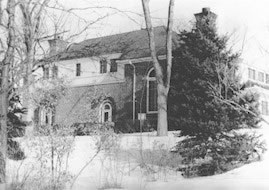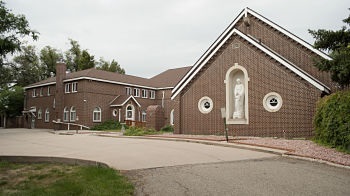Carmelite Monastery
Although not a church, the building at 6138 South Gallup which houses the cloistered order of Carmelite nuns is certainly a religious institution. And the story of the house is possibly as fascinating as that of the sisters who live there.

Carmelite Monastery, 1948.
The home was built in 1912 by architect Jacques Benedict for his new bride, the former June Brown of Denver. She had purchased ninety acres of the original Gallup ranch from Perry Gallup in August that year, when Gallup was forced to move to California for his health. The Benedicts created a beautiful country estate and called it Wyldemere Farm. One source says that they developed the old ranch house into their luxurious mansion. Statuary and a reflecting pool accented the gardens and winding paths. It is not clear whether any of the plantings were those made by Avery and Charlotte Gallup when the acreage was part of their nursery, but included on the grounds was the large lake that is now Ketring Lake.
"Jock" Benedict was an eccentric, a perfectionist, a lover of the good life. Many notable friends of the Benedicts were entertained in their home. Inside, elegant archways led from room to room. The hallway featured an open staircase with turned-wood balusters and extended stair treads that formed display stands for trophies. In the living room were intricately painted ceiling panels and Italian mosaic tile over the fireplace. Jacques Benedict used again the exquisite detailing and perfect scale that characterized his many buildings in the Denver area, including Littleton's Carnegie Library, Town Hall, and First Presbyterian Church.
The home and some ten acres were acquired by Budd and Mary Catherine Howard after June Benedict's death in 1945. Mr. Howard was Denver manager for the Arthur Murray Dance Studio. In 1947 he sold the property to the Discalced Carmelite Nuns of Colorado.
"Discalced" is a term which means unshod or barefoot. This penitential Catholic order wear hemp sandals which they make. They are to use no clothing or bedclothes save wool. When the nuns moved into the monastery, the local newspapers described their lives in the following way. The sisters observe absolute silence except for a short recreational period after supper during which they converse through their prioress. They may not communicate with the outside world except through her, and they use their voices only in the chant of their office, singing hymns, or choral prayer. They tend their gardens, sew church vestments, do chores, and meditate and pray.
Perhaps most severe is the requirement to sleep on a narrow wooden cot and to turn over the board one night each week so as to lie on the inch-high wooden ridges on its reverse side. During their Lent, which runs from mid-September to Easter, the nuns sleep on the ridges three nights a week. Every night they sleep with their arms entwined around a wooden cross. Mass is conducted by priests who come from local churches. They are not visible to the sisters, but say Mass on one side of a high partition, and serve communion through a heavy grill. The contrast between the use of the home by the Benedicts and by the Carmelites could not be greater.

Carmelite Monastery, 2015. Photo by Amelia Martinez.
Before the doors were closed forever on the monastery, the prioress hosted an open-house tour on the last weekend of May in 1948. Visitors saw a "colorfully redecorated and remodeled" residence, called "cheerful, in contrast with the somber brown garb of the nuns." The former Benedict living room had been converted to a beautiful chapel. The dining room had been made into a refectory with wooden tables and backless stools. The remodeling had been done by the prioress, Mother Teresa of Jesus, and Father Frederick McCallin, the priest at St. Mary's Catholic Church in Littleton, with technical advice from architect John K. Monroe.
The public is still welcome to morning Mass in the chapel and the chapel is generally open until 5 p.m., but otherwise the door to the outside world is closed, and the nuns inside carry on their life work -- the worship, the contemplation, and the love of God.
Bibliography
Arapahoe County, Colorado. Clerk and Recorder. Littleton, Colo.: Deed Bk. 74. p. 233; Deed Bk. 592. p. 218-224.
Littleton, (Colo.) Independent. Littleton, Colo.: Littleton Independent Publishers, 1888-
Littleton Museum. Photographic Archives and Biography/Placename Files.
____. Vertical File: "Biography--Benedict."
Noel, Thomas J. and Barbara S. Norgren. Denver, the City Beautiful, and Its Architects, 1893-1941. Denver, Colo.: Historic Denver, Inc., 1987.
Rocky Mountain News. Denver, Colo.: Rocky Mountain News, 1859- .
Seccombe, Dorothy. "Book Of the English Major. Supplement: Survey Of Denver Art and Architecture; Work of J. B. Benedict." Manuscript. Western History Department, Denver Public Library.
Photographs courtesy of the Littleton Museum unless otherwise noted. To order copies, contact the museum at 303-795-3950.
Compiled by Doris Farmer Hulse
Updated April 2021 by Phyllis Larison